Finance Assignment: Bond, Portfolio, and WACC Analysis
VerifiedAdded on 2022/09/16
|9
|1932
|24
Homework Assignment
AI Summary
This finance assignment comprehensively addresses several key areas of financial analysis. It begins with a comparison of bonds and bank loans, including bond valuation calculations across different coupon periods and yields. The assignment then delves into portfolio analysis, calculating returns, st...
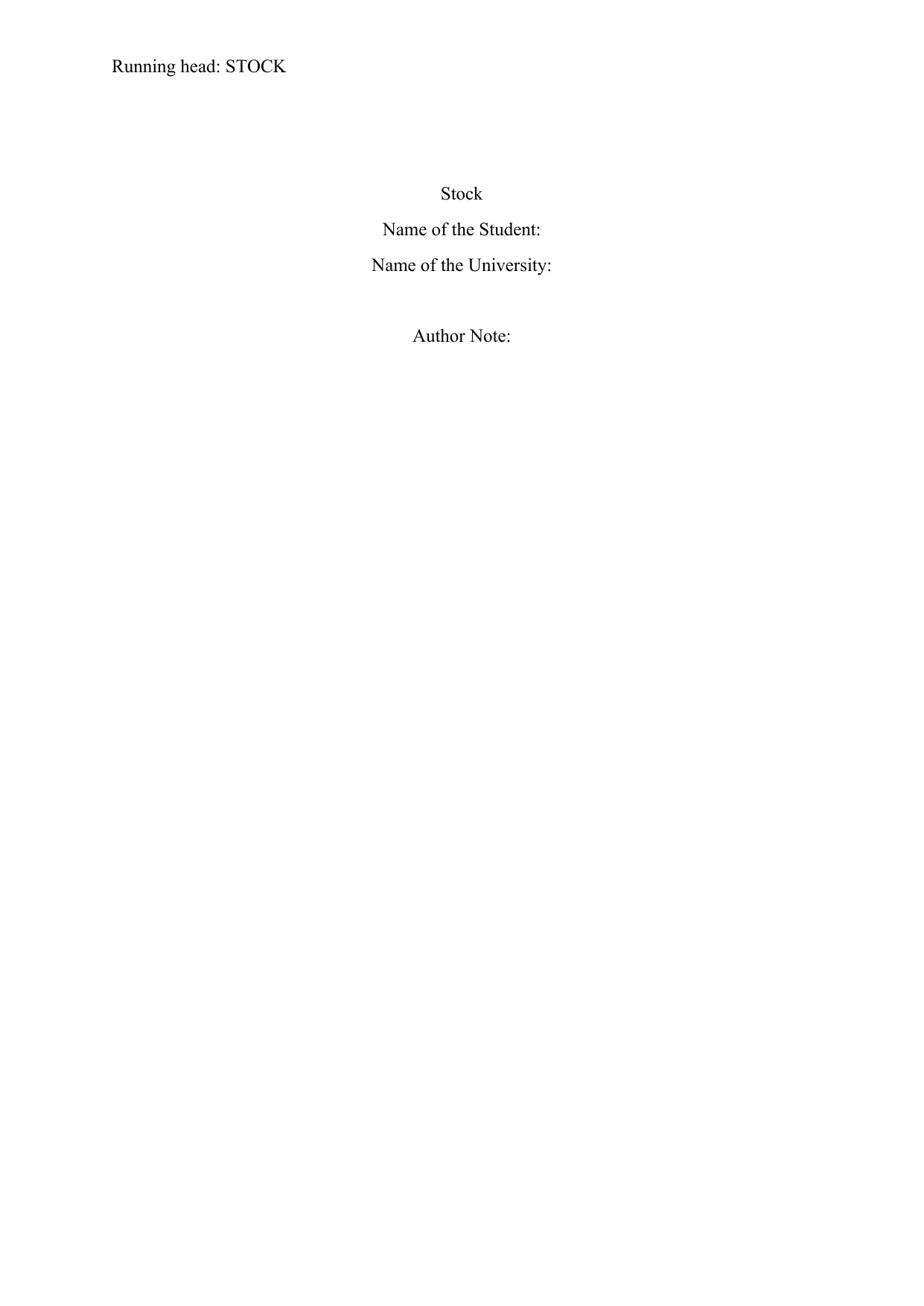
Running head: STOCK
Stock
Name of the Student:
Name of the University:
Author Note:
Stock
Name of the Student:
Name of the University:
Author Note:
Paraphrase This Document
Need a fresh take? Get an instant paraphrase of this document with our AI Paraphraser
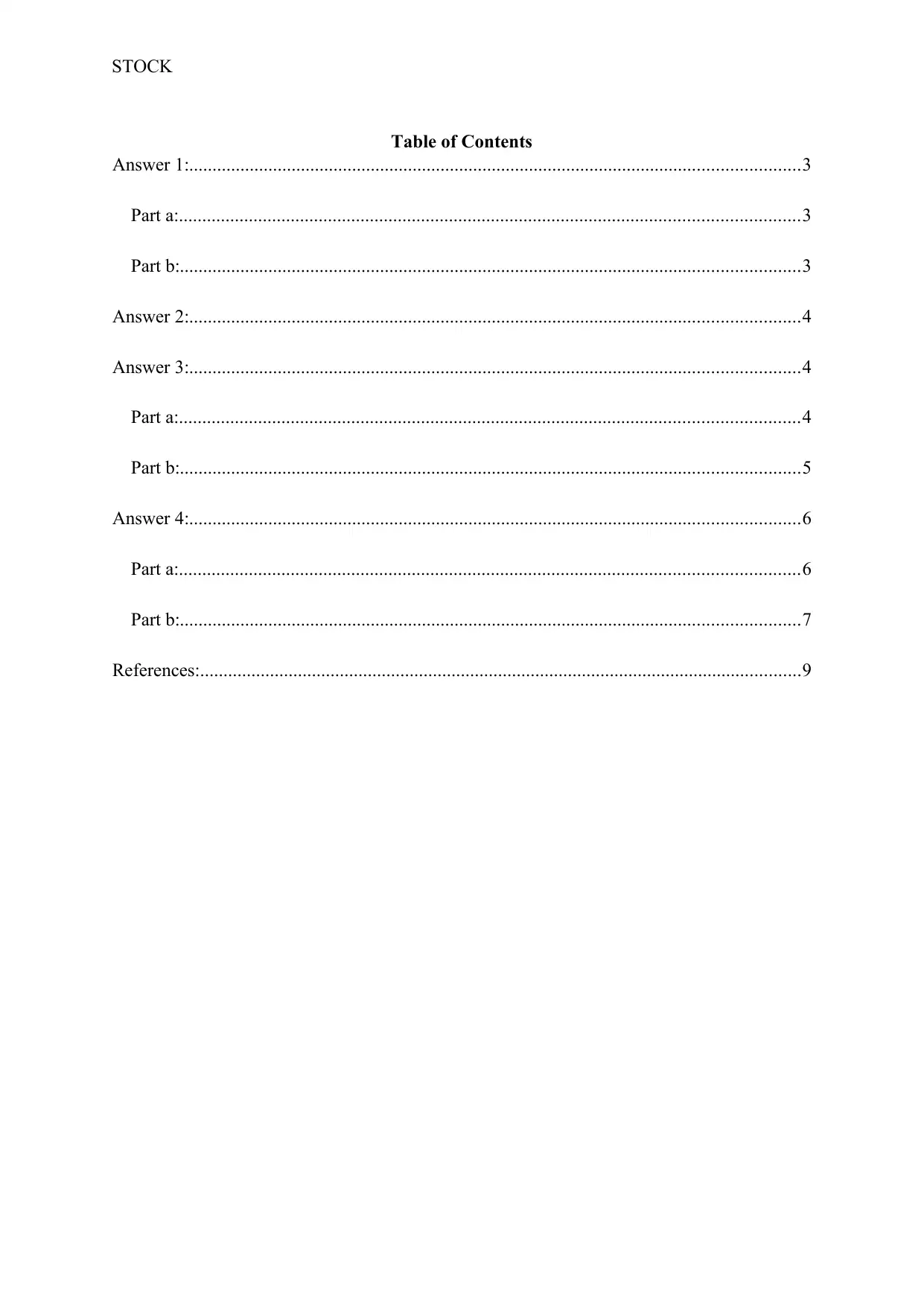
STOCK
Table of Contents
Answer 1:...................................................................................................................................3
Part a:.....................................................................................................................................3
Part b:.....................................................................................................................................3
Answer 2:...................................................................................................................................4
Answer 3:...................................................................................................................................4
Part a:.....................................................................................................................................4
Part b:.....................................................................................................................................5
Answer 4:...................................................................................................................................6
Part a:.....................................................................................................................................6
Part b:.....................................................................................................................................7
References:.................................................................................................................................9
Table of Contents
Answer 1:...................................................................................................................................3
Part a:.....................................................................................................................................3
Part b:.....................................................................................................................................3
Answer 2:...................................................................................................................................4
Answer 3:...................................................................................................................................4
Part a:.....................................................................................................................................4
Part b:.....................................................................................................................................5
Answer 4:...................................................................................................................................6
Part a:.....................................................................................................................................6
Part b:.....................................................................................................................................7
References:.................................................................................................................................9
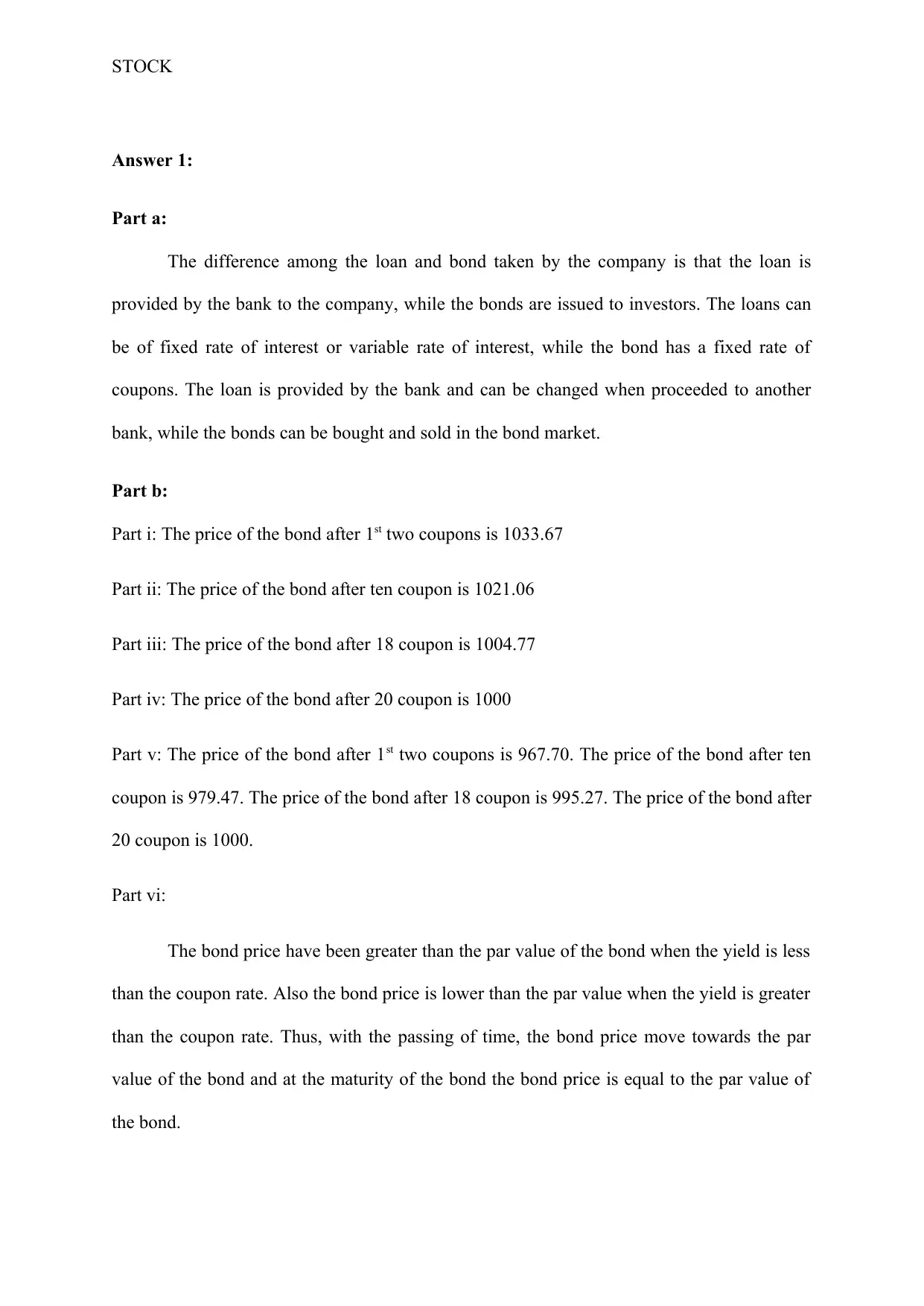
STOCK
Answer 1:
Part a:
The difference among the loan and bond taken by the company is that the loan is
provided by the bank to the company, while the bonds are issued to investors. The loans can
be of fixed rate of interest or variable rate of interest, while the bond has a fixed rate of
coupons. The loan is provided by the bank and can be changed when proceeded to another
bank, while the bonds can be bought and sold in the bond market.
Part b:
Part i: The price of the bond after 1st two coupons is 1033.67
Part ii: The price of the bond after ten coupon is 1021.06
Part iii: The price of the bond after 18 coupon is 1004.77
Part iv: The price of the bond after 20 coupon is 1000
Part v: The price of the bond after 1st two coupons is 967.70. The price of the bond after ten
coupon is 979.47. The price of the bond after 18 coupon is 995.27. The price of the bond after
20 coupon is 1000.
Part vi:
The bond price have been greater than the par value of the bond when the yield is less
than the coupon rate. Also the bond price is lower than the par value when the yield is greater
than the coupon rate. Thus, with the passing of time, the bond price move towards the par
value of the bond and at the maturity of the bond the bond price is equal to the par value of
the bond.
Answer 1:
Part a:
The difference among the loan and bond taken by the company is that the loan is
provided by the bank to the company, while the bonds are issued to investors. The loans can
be of fixed rate of interest or variable rate of interest, while the bond has a fixed rate of
coupons. The loan is provided by the bank and can be changed when proceeded to another
bank, while the bonds can be bought and sold in the bond market.
Part b:
Part i: The price of the bond after 1st two coupons is 1033.67
Part ii: The price of the bond after ten coupon is 1021.06
Part iii: The price of the bond after 18 coupon is 1004.77
Part iv: The price of the bond after 20 coupon is 1000
Part v: The price of the bond after 1st two coupons is 967.70. The price of the bond after ten
coupon is 979.47. The price of the bond after 18 coupon is 995.27. The price of the bond after
20 coupon is 1000.
Part vi:
The bond price have been greater than the par value of the bond when the yield is less
than the coupon rate. Also the bond price is lower than the par value when the yield is greater
than the coupon rate. Thus, with the passing of time, the bond price move towards the par
value of the bond and at the maturity of the bond the bond price is equal to the par value of
the bond.
⊘ This is a preview!⊘
Do you want full access?
Subscribe today to unlock all pages.

Trusted by 1+ million students worldwide
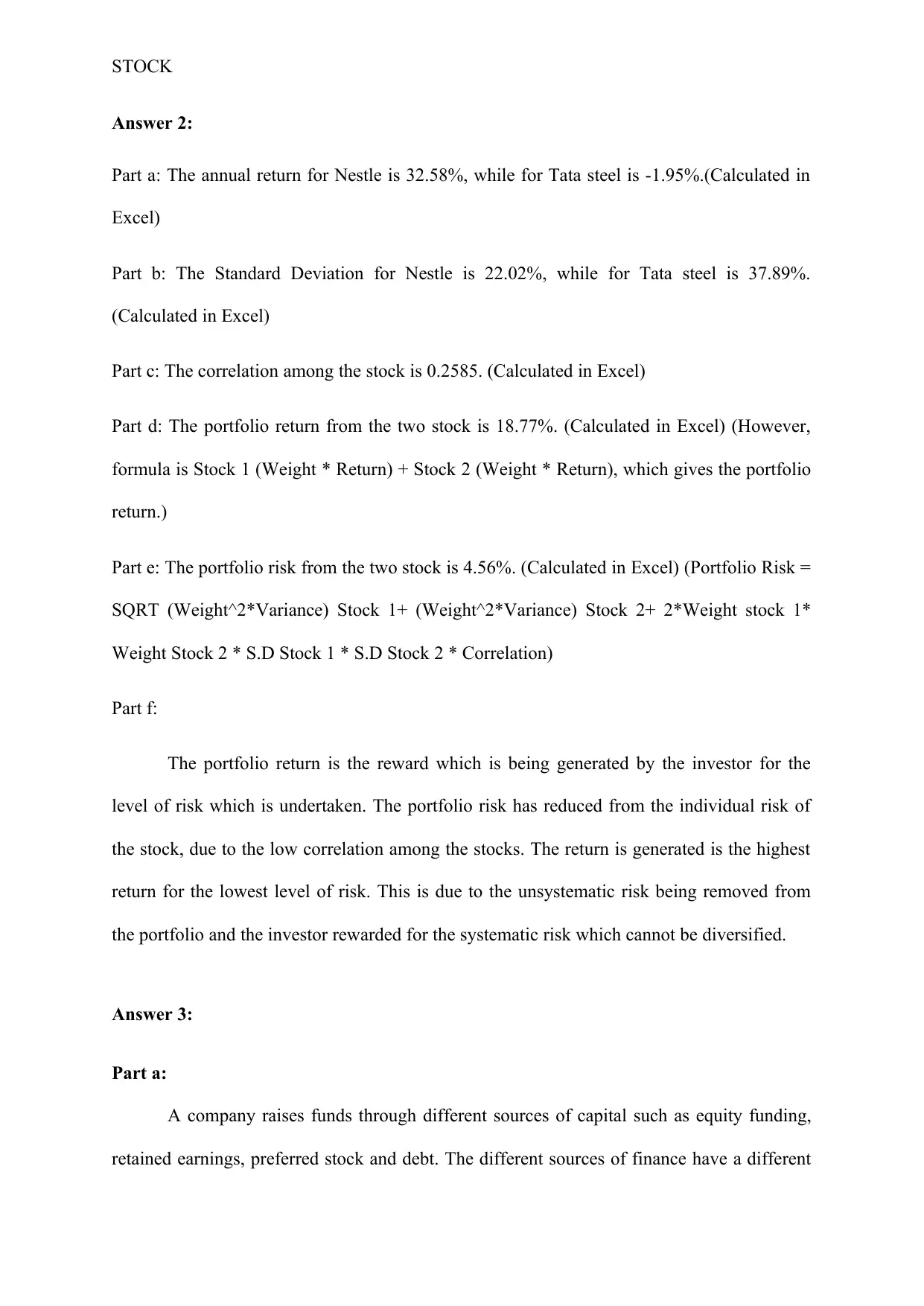
STOCK
Answer 2:
Part a: The annual return for Nestle is 32.58%, while for Tata steel is -1.95%.(Calculated in
Excel)
Part b: The Standard Deviation for Nestle is 22.02%, while for Tata steel is 37.89%.
(Calculated in Excel)
Part c: The correlation among the stock is 0.2585. (Calculated in Excel)
Part d: The portfolio return from the two stock is 18.77%. (Calculated in Excel) (However,
formula is Stock 1 (Weight * Return) + Stock 2 (Weight * Return), which gives the portfolio
return.)
Part e: The portfolio risk from the two stock is 4.56%. (Calculated in Excel) (Portfolio Risk =
SQRT (Weight^2*Variance) Stock 1+ (Weight^2*Variance) Stock 2+ 2*Weight stock 1*
Weight Stock 2 * S.D Stock 1 * S.D Stock 2 * Correlation)
Part f:
The portfolio return is the reward which is being generated by the investor for the
level of risk which is undertaken. The portfolio risk has reduced from the individual risk of
the stock, due to the low correlation among the stocks. The return is generated is the highest
return for the lowest level of risk. This is due to the unsystematic risk being removed from
the portfolio and the investor rewarded for the systematic risk which cannot be diversified.
Answer 3:
Part a:
A company raises funds through different sources of capital such as equity funding,
retained earnings, preferred stock and debt. The different sources of finance have a different
Answer 2:
Part a: The annual return for Nestle is 32.58%, while for Tata steel is -1.95%.(Calculated in
Excel)
Part b: The Standard Deviation for Nestle is 22.02%, while for Tata steel is 37.89%.
(Calculated in Excel)
Part c: The correlation among the stock is 0.2585. (Calculated in Excel)
Part d: The portfolio return from the two stock is 18.77%. (Calculated in Excel) (However,
formula is Stock 1 (Weight * Return) + Stock 2 (Weight * Return), which gives the portfolio
return.)
Part e: The portfolio risk from the two stock is 4.56%. (Calculated in Excel) (Portfolio Risk =
SQRT (Weight^2*Variance) Stock 1+ (Weight^2*Variance) Stock 2+ 2*Weight stock 1*
Weight Stock 2 * S.D Stock 1 * S.D Stock 2 * Correlation)
Part f:
The portfolio return is the reward which is being generated by the investor for the
level of risk which is undertaken. The portfolio risk has reduced from the individual risk of
the stock, due to the low correlation among the stocks. The return is generated is the highest
return for the lowest level of risk. This is due to the unsystematic risk being removed from
the portfolio and the investor rewarded for the systematic risk which cannot be diversified.
Answer 3:
Part a:
A company raises funds through different sources of capital such as equity funding,
retained earnings, preferred stock and debt. The different sources of finance have a different
Paraphrase This Document
Need a fresh take? Get an instant paraphrase of this document with our AI Paraphraser
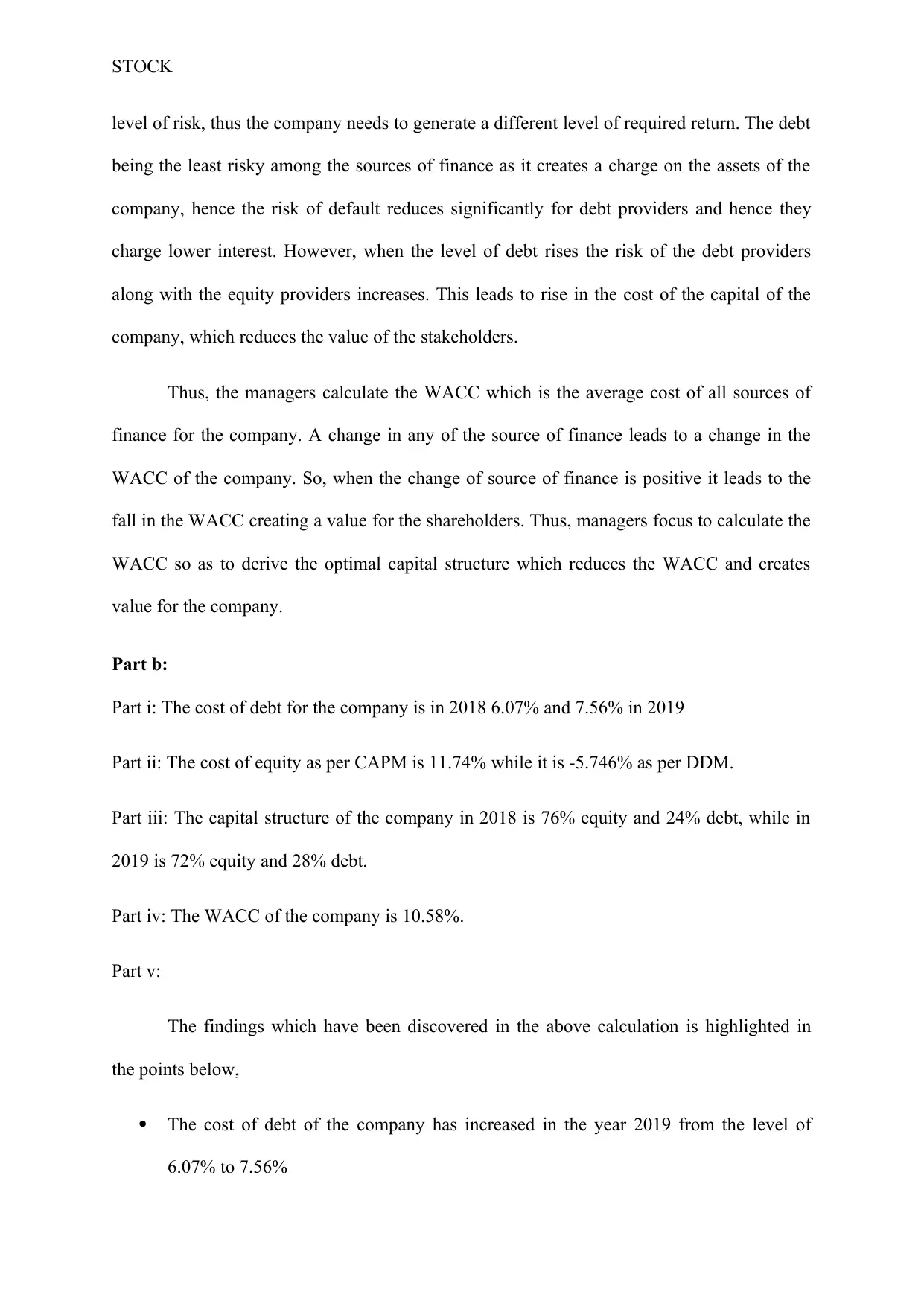
STOCK
level of risk, thus the company needs to generate a different level of required return. The debt
being the least risky among the sources of finance as it creates a charge on the assets of the
company, hence the risk of default reduces significantly for debt providers and hence they
charge lower interest. However, when the level of debt rises the risk of the debt providers
along with the equity providers increases. This leads to rise in the cost of the capital of the
company, which reduces the value of the stakeholders.
Thus, the managers calculate the WACC which is the average cost of all sources of
finance for the company. A change in any of the source of finance leads to a change in the
WACC of the company. So, when the change of source of finance is positive it leads to the
fall in the WACC creating a value for the shareholders. Thus, managers focus to calculate the
WACC so as to derive the optimal capital structure which reduces the WACC and creates
value for the company.
Part b:
Part i: The cost of debt for the company is in 2018 6.07% and 7.56% in 2019
Part ii: The cost of equity as per CAPM is 11.74% while it is -5.746% as per DDM.
Part iii: The capital structure of the company in 2018 is 76% equity and 24% debt, while in
2019 is 72% equity and 28% debt.
Part iv: The WACC of the company is 10.58%.
Part v:
The findings which have been discovered in the above calculation is highlighted in
the points below,
The cost of debt of the company has increased in the year 2019 from the level of
6.07% to 7.56%
level of risk, thus the company needs to generate a different level of required return. The debt
being the least risky among the sources of finance as it creates a charge on the assets of the
company, hence the risk of default reduces significantly for debt providers and hence they
charge lower interest. However, when the level of debt rises the risk of the debt providers
along with the equity providers increases. This leads to rise in the cost of the capital of the
company, which reduces the value of the stakeholders.
Thus, the managers calculate the WACC which is the average cost of all sources of
finance for the company. A change in any of the source of finance leads to a change in the
WACC of the company. So, when the change of source of finance is positive it leads to the
fall in the WACC creating a value for the shareholders. Thus, managers focus to calculate the
WACC so as to derive the optimal capital structure which reduces the WACC and creates
value for the company.
Part b:
Part i: The cost of debt for the company is in 2018 6.07% and 7.56% in 2019
Part ii: The cost of equity as per CAPM is 11.74% while it is -5.746% as per DDM.
Part iii: The capital structure of the company in 2018 is 76% equity and 24% debt, while in
2019 is 72% equity and 28% debt.
Part iv: The WACC of the company is 10.58%.
Part v:
The findings which have been discovered in the above calculation is highlighted in
the points below,
The cost of debt of the company has increased in the year 2019 from the level of
6.07% to 7.56%
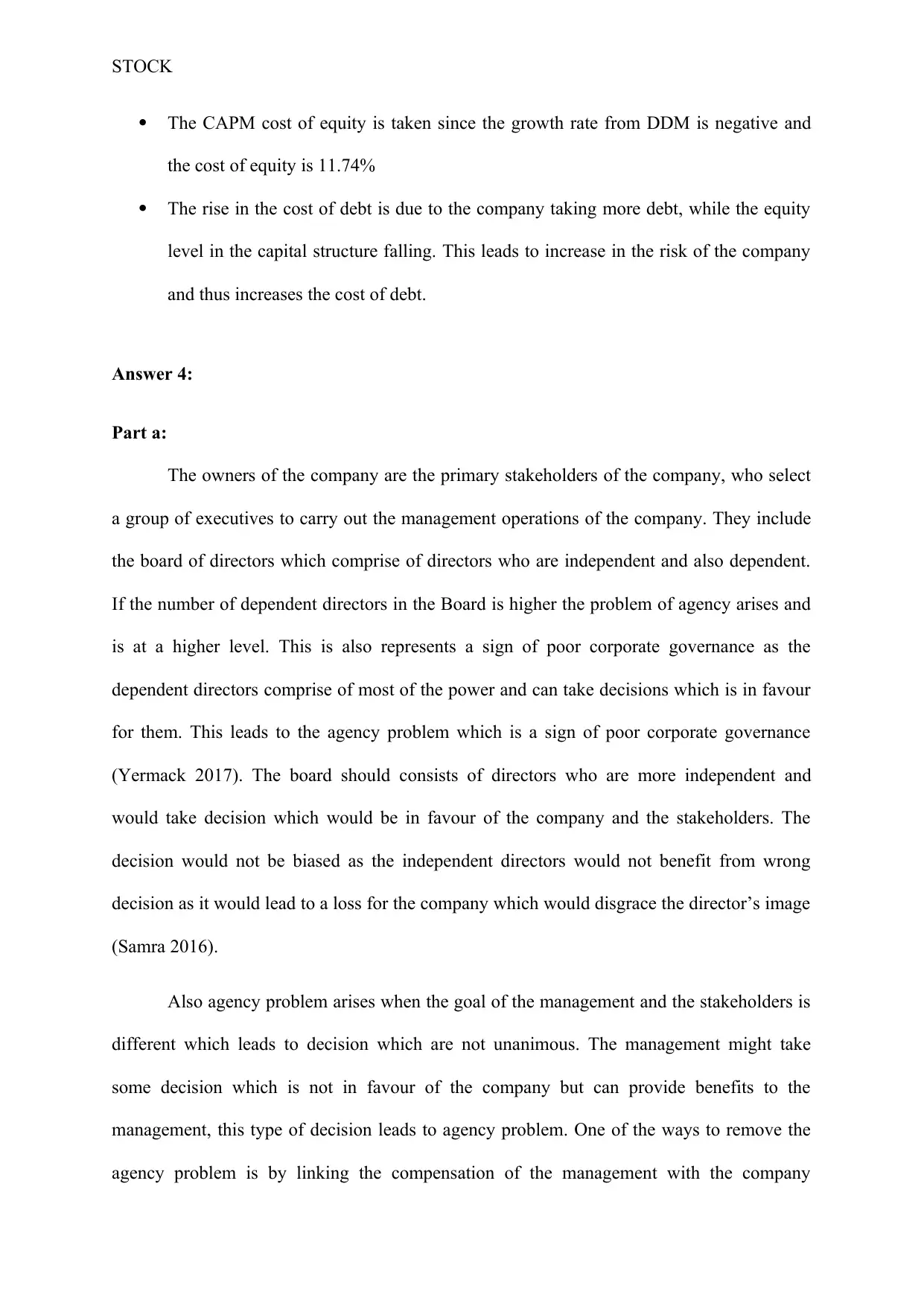
STOCK
The CAPM cost of equity is taken since the growth rate from DDM is negative and
the cost of equity is 11.74%
The rise in the cost of debt is due to the company taking more debt, while the equity
level in the capital structure falling. This leads to increase in the risk of the company
and thus increases the cost of debt.
Answer 4:
Part a:
The owners of the company are the primary stakeholders of the company, who select
a group of executives to carry out the management operations of the company. They include
the board of directors which comprise of directors who are independent and also dependent.
If the number of dependent directors in the Board is higher the problem of agency arises and
is at a higher level. This is also represents a sign of poor corporate governance as the
dependent directors comprise of most of the power and can take decisions which is in favour
for them. This leads to the agency problem which is a sign of poor corporate governance
(Yermack 2017). The board should consists of directors who are more independent and
would take decision which would be in favour of the company and the stakeholders. The
decision would not be biased as the independent directors would not benefit from wrong
decision as it would lead to a loss for the company which would disgrace the director’s image
(Samra 2016).
Also agency problem arises when the goal of the management and the stakeholders is
different which leads to decision which are not unanimous. The management might take
some decision which is not in favour of the company but can provide benefits to the
management, this type of decision leads to agency problem. One of the ways to remove the
agency problem is by linking the compensation of the management with the company
The CAPM cost of equity is taken since the growth rate from DDM is negative and
the cost of equity is 11.74%
The rise in the cost of debt is due to the company taking more debt, while the equity
level in the capital structure falling. This leads to increase in the risk of the company
and thus increases the cost of debt.
Answer 4:
Part a:
The owners of the company are the primary stakeholders of the company, who select
a group of executives to carry out the management operations of the company. They include
the board of directors which comprise of directors who are independent and also dependent.
If the number of dependent directors in the Board is higher the problem of agency arises and
is at a higher level. This is also represents a sign of poor corporate governance as the
dependent directors comprise of most of the power and can take decisions which is in favour
for them. This leads to the agency problem which is a sign of poor corporate governance
(Yermack 2017). The board should consists of directors who are more independent and
would take decision which would be in favour of the company and the stakeholders. The
decision would not be biased as the independent directors would not benefit from wrong
decision as it would lead to a loss for the company which would disgrace the director’s image
(Samra 2016).
Also agency problem arises when the goal of the management and the stakeholders is
different which leads to decision which are not unanimous. The management might take
some decision which is not in favour of the company but can provide benefits to the
management, this type of decision leads to agency problem. One of the ways to remove the
agency problem is by linking the compensation of the management with the company
⊘ This is a preview!⊘
Do you want full access?
Subscribe today to unlock all pages.

Trusted by 1+ million students worldwide
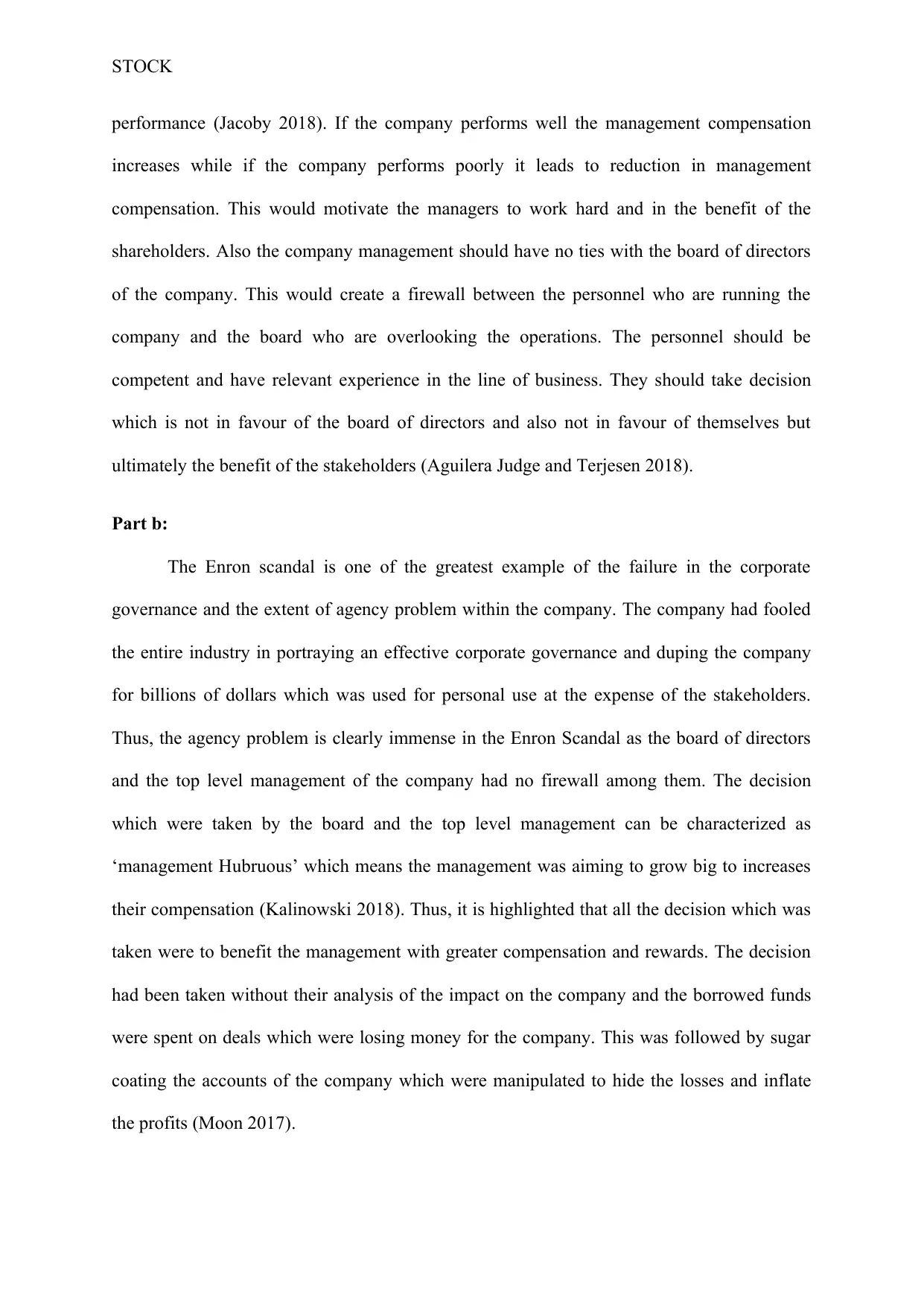
STOCK
performance (Jacoby 2018). If the company performs well the management compensation
increases while if the company performs poorly it leads to reduction in management
compensation. This would motivate the managers to work hard and in the benefit of the
shareholders. Also the company management should have no ties with the board of directors
of the company. This would create a firewall between the personnel who are running the
company and the board who are overlooking the operations. The personnel should be
competent and have relevant experience in the line of business. They should take decision
which is not in favour of the board of directors and also not in favour of themselves but
ultimately the benefit of the stakeholders (Aguilera Judge and Terjesen 2018).
Part b:
The Enron scandal is one of the greatest example of the failure in the corporate
governance and the extent of agency problem within the company. The company had fooled
the entire industry in portraying an effective corporate governance and duping the company
for billions of dollars which was used for personal use at the expense of the stakeholders.
Thus, the agency problem is clearly immense in the Enron Scandal as the board of directors
and the top level management of the company had no firewall among them. The decision
which were taken by the board and the top level management can be characterized as
‘management Hubruous’ which means the management was aiming to grow big to increases
their compensation (Kalinowski 2018). Thus, it is highlighted that all the decision which was
taken were to benefit the management with greater compensation and rewards. The decision
had been taken without their analysis of the impact on the company and the borrowed funds
were spent on deals which were losing money for the company. This was followed by sugar
coating the accounts of the company which were manipulated to hide the losses and inflate
the profits (Moon 2017).
performance (Jacoby 2018). If the company performs well the management compensation
increases while if the company performs poorly it leads to reduction in management
compensation. This would motivate the managers to work hard and in the benefit of the
shareholders. Also the company management should have no ties with the board of directors
of the company. This would create a firewall between the personnel who are running the
company and the board who are overlooking the operations. The personnel should be
competent and have relevant experience in the line of business. They should take decision
which is not in favour of the board of directors and also not in favour of themselves but
ultimately the benefit of the stakeholders (Aguilera Judge and Terjesen 2018).
Part b:
The Enron scandal is one of the greatest example of the failure in the corporate
governance and the extent of agency problem within the company. The company had fooled
the entire industry in portraying an effective corporate governance and duping the company
for billions of dollars which was used for personal use at the expense of the stakeholders.
Thus, the agency problem is clearly immense in the Enron Scandal as the board of directors
and the top level management of the company had no firewall among them. The decision
which were taken by the board and the top level management can be characterized as
‘management Hubruous’ which means the management was aiming to grow big to increases
their compensation (Kalinowski 2018). Thus, it is highlighted that all the decision which was
taken were to benefit the management with greater compensation and rewards. The decision
had been taken without their analysis of the impact on the company and the borrowed funds
were spent on deals which were losing money for the company. This was followed by sugar
coating the accounts of the company which were manipulated to hide the losses and inflate
the profits (Moon 2017).
Paraphrase This Document
Need a fresh take? Get an instant paraphrase of this document with our AI Paraphraser
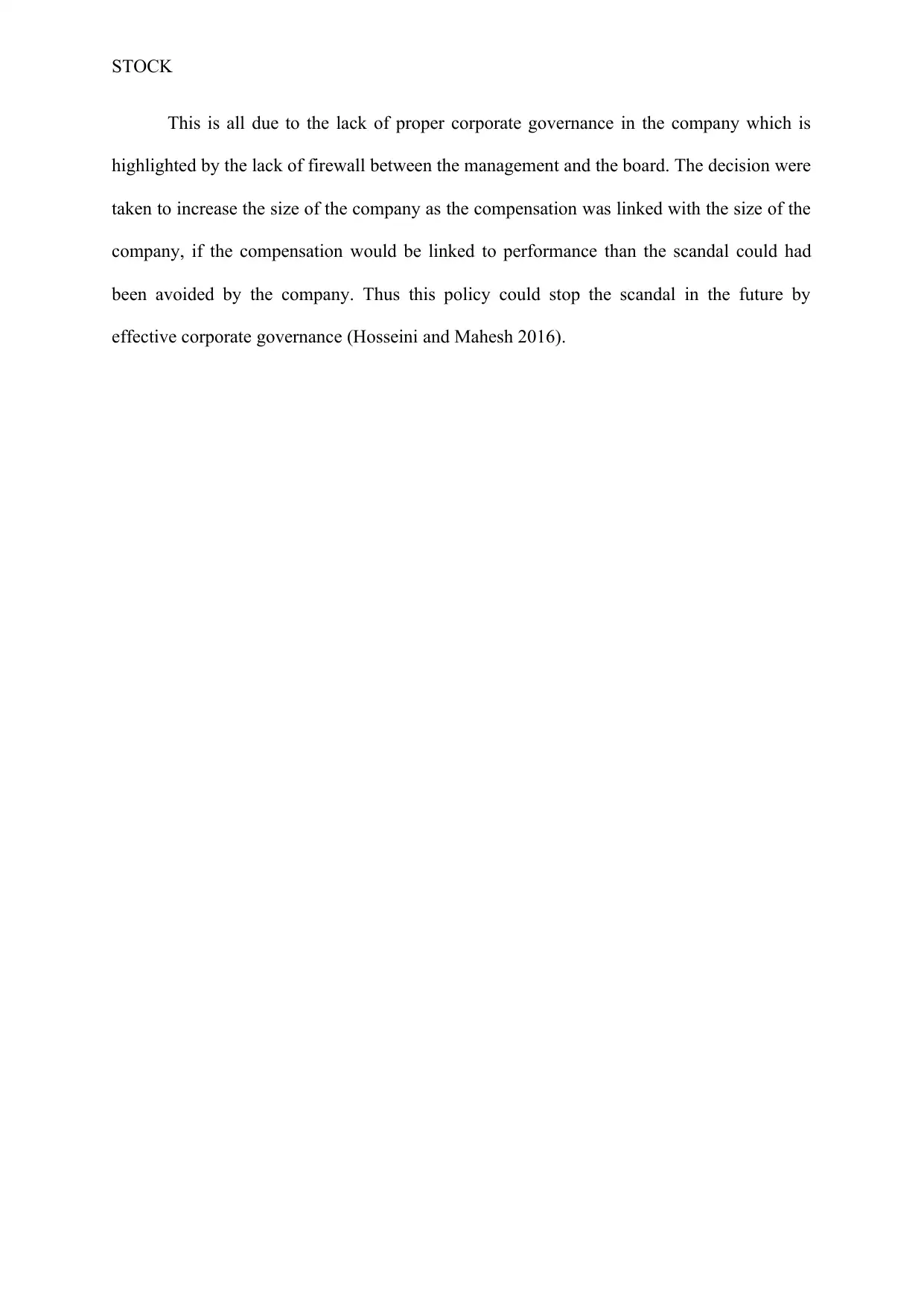
STOCK
This is all due to the lack of proper corporate governance in the company which is
highlighted by the lack of firewall between the management and the board. The decision were
taken to increase the size of the company as the compensation was linked with the size of the
company, if the compensation would be linked to performance than the scandal could had
been avoided by the company. Thus this policy could stop the scandal in the future by
effective corporate governance (Hosseini and Mahesh 2016).
This is all due to the lack of proper corporate governance in the company which is
highlighted by the lack of firewall between the management and the board. The decision were
taken to increase the size of the company as the compensation was linked with the size of the
company, if the compensation would be linked to performance than the scandal could had
been avoided by the company. Thus this policy could stop the scandal in the future by
effective corporate governance (Hosseini and Mahesh 2016).
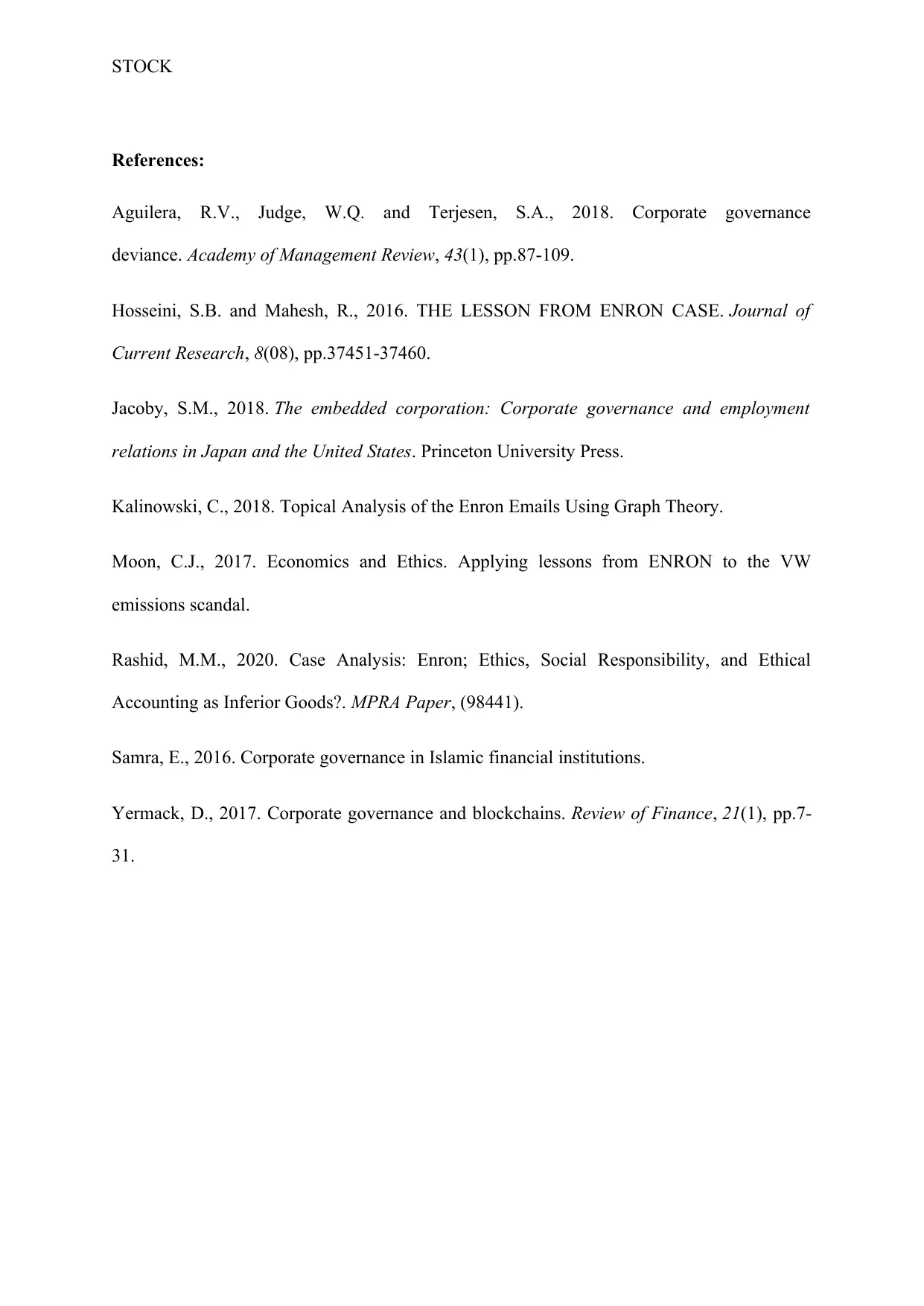
STOCK
References:
Aguilera, R.V., Judge, W.Q. and Terjesen, S.A., 2018. Corporate governance
deviance. Academy of Management Review, 43(1), pp.87-109.
Hosseini, S.B. and Mahesh, R., 2016. THE LESSON FROM ENRON CASE. Journal of
Current Research, 8(08), pp.37451-37460.
Jacoby, S.M., 2018. The embedded corporation: Corporate governance and employment
relations in Japan and the United States. Princeton University Press.
Kalinowski, C., 2018. Topical Analysis of the Enron Emails Using Graph Theory.
Moon, C.J., 2017. Economics and Ethics. Applying lessons from ENRON to the VW
emissions scandal.
Rashid, M.M., 2020. Case Analysis: Enron; Ethics, Social Responsibility, and Ethical
Accounting as Inferior Goods?. MPRA Paper, (98441).
Samra, E., 2016. Corporate governance in Islamic financial institutions.
Yermack, D., 2017. Corporate governance and blockchains. Review of Finance, 21(1), pp.7-
31.
References:
Aguilera, R.V., Judge, W.Q. and Terjesen, S.A., 2018. Corporate governance
deviance. Academy of Management Review, 43(1), pp.87-109.
Hosseini, S.B. and Mahesh, R., 2016. THE LESSON FROM ENRON CASE. Journal of
Current Research, 8(08), pp.37451-37460.
Jacoby, S.M., 2018. The embedded corporation: Corporate governance and employment
relations in Japan and the United States. Princeton University Press.
Kalinowski, C., 2018. Topical Analysis of the Enron Emails Using Graph Theory.
Moon, C.J., 2017. Economics and Ethics. Applying lessons from ENRON to the VW
emissions scandal.
Rashid, M.M., 2020. Case Analysis: Enron; Ethics, Social Responsibility, and Ethical
Accounting as Inferior Goods?. MPRA Paper, (98441).
Samra, E., 2016. Corporate governance in Islamic financial institutions.
Yermack, D., 2017. Corporate governance and blockchains. Review of Finance, 21(1), pp.7-
31.
⊘ This is a preview!⊘
Do you want full access?
Subscribe today to unlock all pages.

Trusted by 1+ million students worldwide
1 out of 9
Related Documents
Your All-in-One AI-Powered Toolkit for Academic Success.
+13062052269
info@desklib.com
Available 24*7 on WhatsApp / Email
![[object Object]](/_next/static/media/star-bottom.7253800d.svg)
Unlock your academic potential
© 2024 | Zucol Services PVT LTD | All rights reserved.




